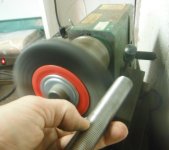I bought one of these new when I was just out of high school (1969) at which point they cost $125, which seemed like a fortune to me then. I no longer even remember what specific task caused me to cough up that much money for anything that wasn't possible to drive on the road, but there was something I needed it for and that it did. It comes with a post so you can remove the headstock and mount it to do milling operations within the limited X-Y range of the bed and cross-slide. It has a tailstock and both spindle and tailstock dead centers (same size). Accessories available at the time included a change gear set and lead screw for threading and power feed, a watchmaker's collet spindle and collets, a live center and other odds and ends.
The cross slide on this tool is not compound—it's most sever limitation, IMHO—so tapers are turned by loosening the set screw to rotating the headstock at the desired angle. I made my 1911 trigger work fixture on this machine, including the tapered roller set that compensates for parallelism error in the sear and hammer pin holes that may be in a frame. Over time I turned knobs and firing pins and even a special drop tube for my Dillon Square Deal. I milled sight dovetails in small pistol slides. I made a shell holder adapter for a Lee Load-all to take shortened shells, and made a number small tools, lamp housings, heat sinks and other items. Everything took awhile on it because it can't make deep cuts, but, with patience, I got a lot done on it before I could afford full size, full feature machinery or a place with enough room to keep them in.
The knobs have 20 graduations per rotation and the feed threads are one millimeter per turn (these were made in Austria, and so are metric), so each graduation is very close to 0.002" (0.0019685" and change), but close enough to two thousandths that you can use them. The machine is not very rigid, so you constantly recheck your turning work with a micrometer anyway. The dial indicators are another approach to take.
One thing I did with mine was get some bushing bronze and turn anti-backlash screws for it. Backlash is significant in mine, partly from a lot of wear and tear.
It is, indeed, a good way to learn machining principles. Use that owner's manual to learn some of its special setups, like how to realign the headstock with the tailstock and dead center after moving it to turn a taper or for the milling setup.


